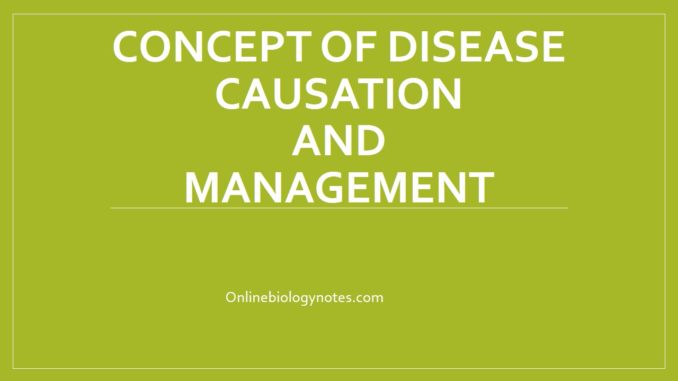
Disease causation:
- Any event or condition, characteristics or combination of these factor which plays an important role in producing the disease cause may not be a single factor and often comprises several components.
- For e.g., in case of food poisoning due to Salmonella. The presence of Salmonella is necessary cause. Contaminated food (salad) is the sufficient cause.
- Necessary cause is the component of sufficient cause.
Factors involved in disease causation:
- Four types of factors that play important role in disease causation.
- Predisposing factor
- Enabling
- Precipitating
- Re-enforcing factor
- Predisposing factor may create a state of susceptibility of disease to host. E.g., age, sex, previous illness.
- Enabling factor favours the development of disease. E.g., poor housing, poor sanitation, poor nutrition, low economy.
- Precipitating factor is most important for disease causation. It is associated with onset of disease. E.g., exposure to specific infectious agents or toxins.
- Re-enforcing factor may aggravate and establish disease. E.g, repeated exposure, hardwork.
Establishing cause of disease:
Causal inference:
- It is the term used for the process of determining whether observed association are likely to be causal for establishing disease.
- Guidelines for causal inference:
- Temporal relationship:
- Most crucial factor cause must proceed the effect (disease). This type of relation is called temporal relationship.
- In case of case control and cross-sectional study, confusion may arise but in case of longitudinal study or experimental study it can be determined.
- Plausibility:
- Association should be possible (plausible).
- Is the association consistent with the knowledge or not?
- Consistency:
- Different studies should lead the same result.
- Strength:
- Strength should be higher. It can be determined by odds ratio.
- Dose-response relationships:
- Should be applicable to the cause and effect.
- Reversibility:
- If exposure is present, effect is seen and on removal of exposure causes absence of effect.
- Study design:
- Judging the evidence:
- There is no completely reliable criteria for guiding the result.
- It is tentative and uncertainty remain must important guideline is temporal relation, plausibility, study design, consistency etc.
- Temporal relationship:
Natural history of disease:
- Co-interrupted pathway of disease. It refers to the description of uninterrupted progression of disease in an individual from the moment of exposure to causal agent until death, recovery or disability.
- Deletion and treatment of any stage of disease can alter the natural history.
- It comprises various stages:
- Pre-pathogenesis phage: Interaction between agent, host and environment.
- Pathogenesis phage: Entry of pathogen, incubation period and appearance of sign and symptoms of disease. This phage is called pathogenesis phage.
- Late pathogenesis phage: recovery, disability or death
- Prognosis: Prediction of the course of particular event of disease that will occur in future.
- Based on defined group of patients and can be done by clear understanding of natural history of disease.
Interaction of agent, host and environment
- Can be bi-directional or triangular
- Agent – environment interaction
- Host – environment interaction
- Host-agent interaction
- Agent-host-environment interaction
Management of disease:
- Prevent, control, elimination, eradication
Prevention:
- Can be done in four level corresponding to the phases of disease development. They are:
- Primordial prevention (most recent concern)
- Primary prevention
- Secondary prevention
- Tertiary prevention
- Primordial:
- It was identified as increase in knowledge of epidemiology of cardiovascular disease.
- The base underlying cause of coronary heart diseases have identified as diet high in saturated fatty acid.
- Aim of primordial prevention is to avoid the emergence and establishment of social, economic, and cultural pattern of living to host contributed to elevated risk of disease, primordial prevention helps in declining the mortality from infectious diseases and reducing un-intentional injuries and diseases such as cancer coronary heart disease by avoiding high risk behavior.
- Effective primordial prevention requires strong government, regulatory and fiscal action to stop the promotions of the items that increase the risk.
- Primary prevention:
- The aim of prevention is to limit the incidence of disease by controlling causes and risk factor.
- Primary prevention involves two strategy:
- Population strategy
- High risk individual strategy
- Secondary prevention:
- The aim is to cure patient and reduce the more serious consequences of disease through early diagnosis and treatment.
- It comprises the measure available to individuals and population for early detection and prevent the effective interventions.
- It Is directed at the period between onset of disease and normal time of diagnosis and aims to reduce prevalence of disease.
- Main requirement of useful secondary prevention program are:
- Safe and accurate methods of disease detection, preferably of preclinical state.
- Effective method of intervention.
- Tertiary prevention:
- The aim is to reduce the progress or compilation of established disease.
- It reduces impairment and disability and minimize suffering due to disease.
